Worthing Pier temporary closure (October 2024)
In October 2024 we had to temporarily close Worthing Pier for the safety of the public while we carried out emergency repairs. This page has been created to give you a fuller picture of what has happened and why. We update it regularly so you always have the most up-to-date information about the situation. We acted as quickly as possible to get this unique and precious asset back into a safe state where people could enjoy it again.
What's happened
On 4th October 2024, our engineers identified that one of the iron piles that support Worthing Pier was damaged.
The pile was on the east side of the pier, just to the north of the southern pavilion. The middle of the pile had been broken, which we suspect was caused by a large piece of floating debris during severe weather.
Photo: Damage to Worthing Pier - the snapped pile before it was removed
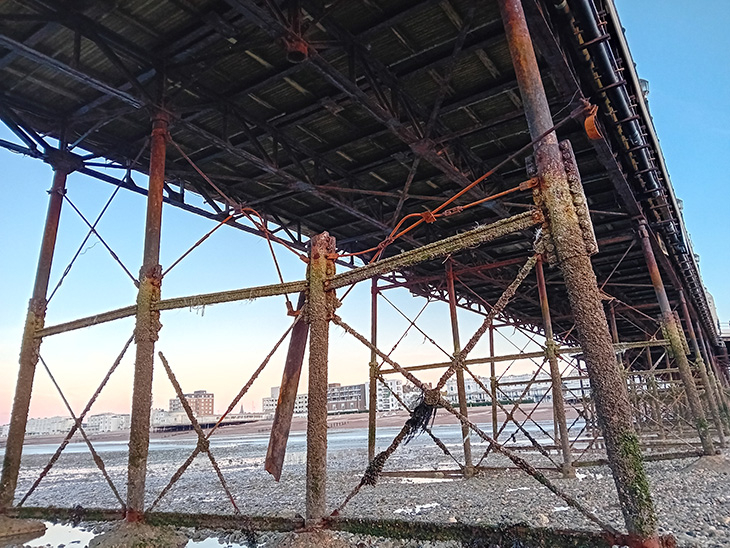
Our contractors removed the damaged pile and we began working on a plan to replace it, when the conditions were safe enough for us to do so.
Photo: Damage to Worthing Pier - the gap when the snapped pile had been removed
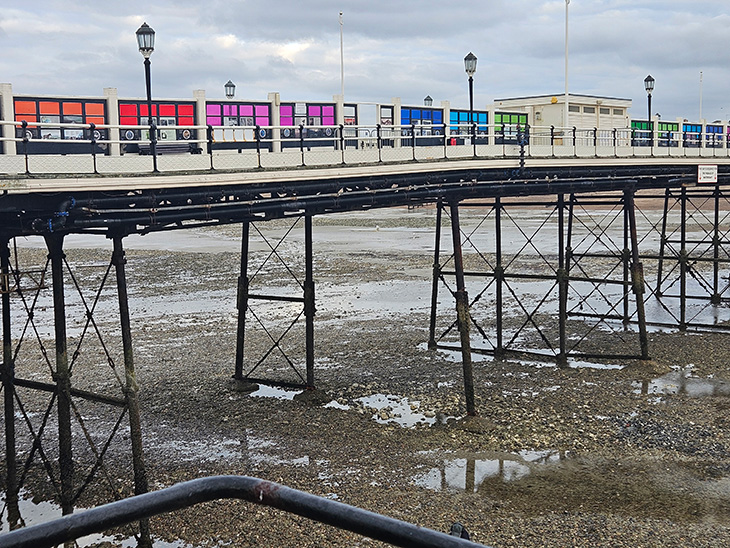
The advice we received from independent structural engineering experts is that there was a risk to public safety if people were allowed to continue using the pier in that condition. The safety of the public is our priority so we therefore temporarily closed the pier while it could be made safe to use again.
We requested that no one walked beneath the pier at this time, in addition to any watercraft including boats and paddleboards. We also wrote to local fishermen and harbour authorities about this.
We carry out regular quarterly inspections of the pier and we believe this is the first time in more than 25 years that such an event has happened.
What we've done
We brought in our pier substructure maintenance contractor as soon as we discovered the issue and also secured further advice from independent national engineering experts HOP Consulting about the structure, its safety and the required repairs. HOP Consulting has a good working knowledge of Worthing Pier, having carried out a comprehensive inspection for the council in 2018. HOP Consulting has also worked on a number of piers and similar structures around the country.
HOP Consulting sent us an interim report which made it clear that there was a risk to the public if we allowed the pier to remain fully open. The safety of the public is our priority so we therefore closed the pier on the evening of 9th October 2024.
On 4th October we had alerted the businesses on the pier about the potential that we could need to close the pier on safety grounds, which we confirmed to them on 9th October. We had visited those businesses that were open on 8th October.
HOP Consulting submitted its full inspection report of its findings. In summary, the report confirmed the need for the pier to be closed until it has been made safe.
One of the biggest challenges is that the initial stages of the work could only take place at a spring low tide, when the tide goes far enough out for us to do the work safely. The first such set of tides began on Tuesday 15th October and ran until Sunday 21st October but because of supply issues our contractors were unable to get the work done in that period.
Unfortunately while we were examining the piles on either side of the one that we had to remove, we discovered that they too had suffered damage which was hidden from view. We believe this was caused by the extra strain they were under from the weight of the pier.
We stabilised those piles but the damage they had suffered meant we needed to carry out more work to mitigate the strain on them.
Throughout the closure we gave regular updates to our rate-paying tenants on the pier as we understood how damaging the closure was to their businesses.
Separately, we liaised with the Worthing Lions about the use of the pier for their annual 5th November fireworks display, but together had to make the decision to cancel the event because there was no suitable alternative venue available.
Reopening the pier
A solution was developed that involved the installation of a new steel support structure running the full width of the pier, to take on the role of the existing cast iron piles that had been damaged and were no longer able to do their job effectively.
The initial phase of the work could only be completed safely from the beach. This meant that the contractors could only operate during spring low tides, when the sea was out far enough for the beach to be fully accessible.
As spring low tides only last for about a week in every month, this meant the project could have extended into December or even January, with the pier having to remain closed. Instead, by working day and night and making excellent early progress, the teams developed a new approach where the final part of the work could be completed from above, using scaffolding on the pier.
Working from above proved so effective that the activity was able to be completed in a fraction of the expected time - despite interruptions from storms and difficult sea conditions.
The required welding and bracing work was completed on Thursday 28th November 2024, allowing for final inspections to be carried out and the scaffolding to be dismantled.
Next steps
Some repair and maintenance work on the pier was identified during the above-deck work and this will be completed early in the new year.
As well as continuing with routine maintenance, our teams will carry out frequent checks on the new steel support structure over the coming months to ensure that it has all the bracing it needs to do its job under constant pressure from the tides and the weight of the pier.
Our engineers will also work with contractors to identify exactly what is needed for a permanent repair for the pier.
Latest updates
Our contractors have completed the repairs on the damaged glazing of the central screen on the pier.
There's some additional electrical repair work to do on the pier lighting and that will be organised over the coming weeks.
Worthing Pier has reopened to visitors after almost two months of emergency work to make it safe for the community again.
Work to maintain and preserve the pier is an ongoing effort. As well as continuing with routine maintenance, our teams will carry out frequent checks on the new steel support structure over the coming months to ensure that it has all the bracing it needs to do its job under constant pressure from the tides and the weight of the pier.
Engineers will also work with contractors to identify exactly what is needed for a permanent repair for the pier.
We have now completed the majority of our electrical work on sections of the pier lighting ahead of the pier reopening tomorrow morning. Our contractors have replaced some loose decking planks as well as a number of gratings on the landing stage. They've also begun repairing some of the damaged central panel glazing.
Meanwhile, our engineers have been out inspecting the new steel support structure. As it is a newly-fitted temporary structure, we'll be doing frequent checks on it over the coming months.
Photo: damaged central panel glazing to be repaired
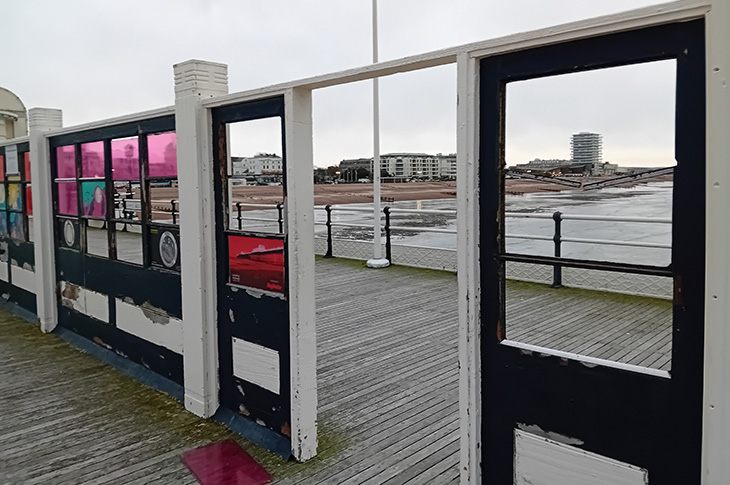
All of the scaffolding has now been removed from the pier but to help keep people safe we've installed some security fencing to try to prevent access to the new steel support structure.
Our teams have also been carrying out electrical checks on the pier lighting today ahead of opening on Wednesday (4th December 2024).
Photo: security fencing to stop access to the works under the pier
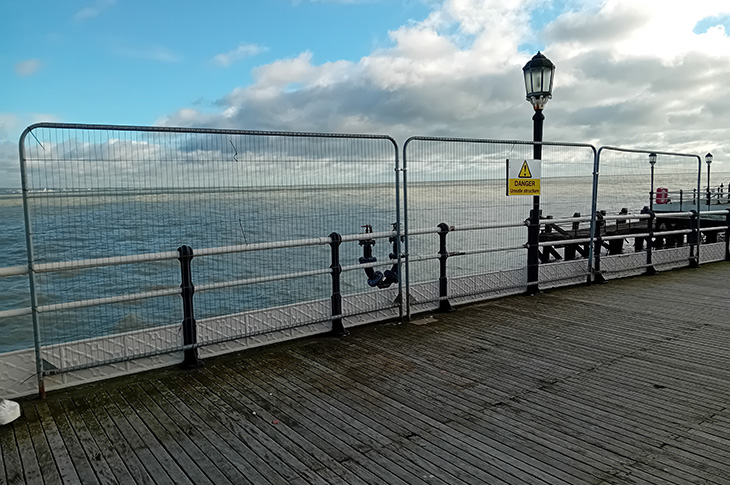
The scaffolding is today being dismantled so that the pier can be fully reopened to the public.
There is still some minor repair work needed before we can unlock the gates for the community and we plan to have that all done early next week.
Photo: a picture from the end of the pier looking north
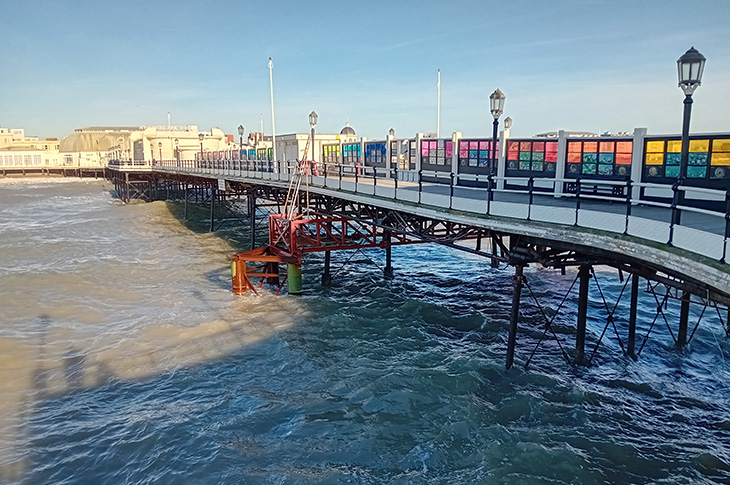
Our contractors have today managed to complete all of the welding and bracing needed on the pier's new steel support structure.
That means the teams will begin taking down the scaffolding they have been using to access the site from above and attention can turn to the remaining work needed to reopen the pier to the public.
Photo: additional bracing under the pier

All of the scaffolding for the pier has now been installed, so that the welding and bracing needed on the steel support structure can be completed.
Progress has been restricted by strong winds and tides that have sent waves repeatedly crashing onto our temporary working platform, but our contractors have managed to get more of the welding work done today.
Photo: the steel support structure under the pier
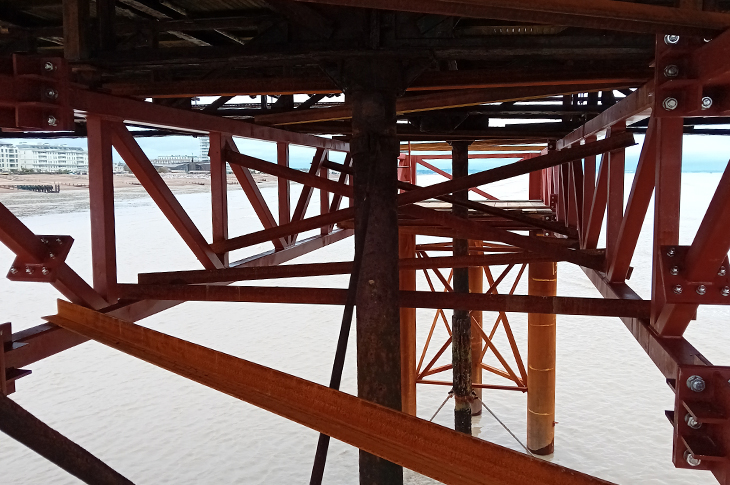

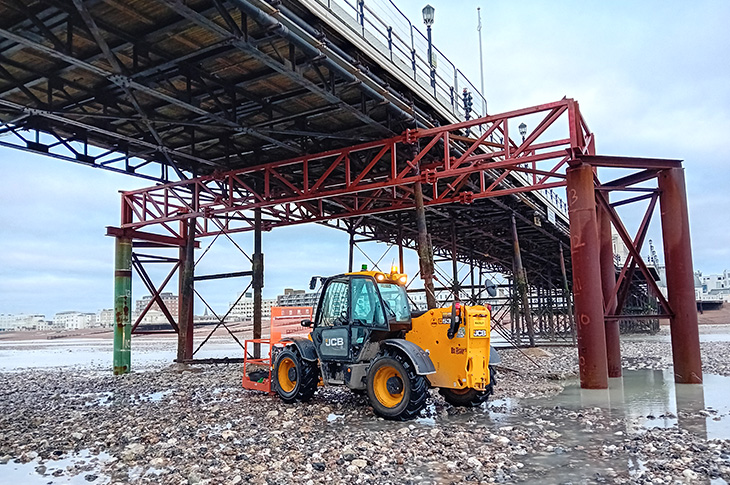
The installation of scaffolding on the east side of the pier has been completed and our contractors have today begun carrying out the final sections of welding and bracing necessary on that side of the new steel support structure.
While that work is completed, scaffolding is being constructed on the west side of the pier so that the remaining welding and bracing needed can begin on that side as well.
Photo: contractors carrying out sections of welding and bracing
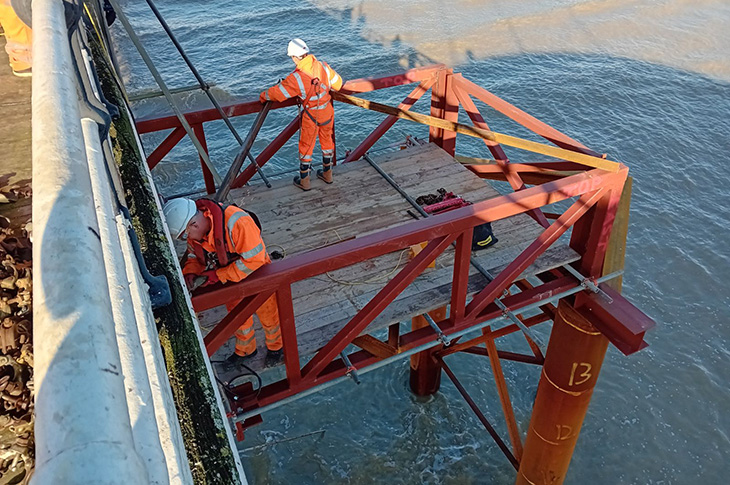
Our contractors today began building the scaffolding on the east side of the pier which will allow us to complete the remainder of the project from above, rather than having to wait for the next set of spring low tides to work from the beach.
They are constructing a temporary working platform that will rest on the bracing of the new steel support structure, allowing the final sections of welding to be completed in the coming days.
Photo: close up view of the piers, trusses, scaffolding and temporary working platform

Photo: the piers, trusses, scaffolding and temporary working platform (wide view)
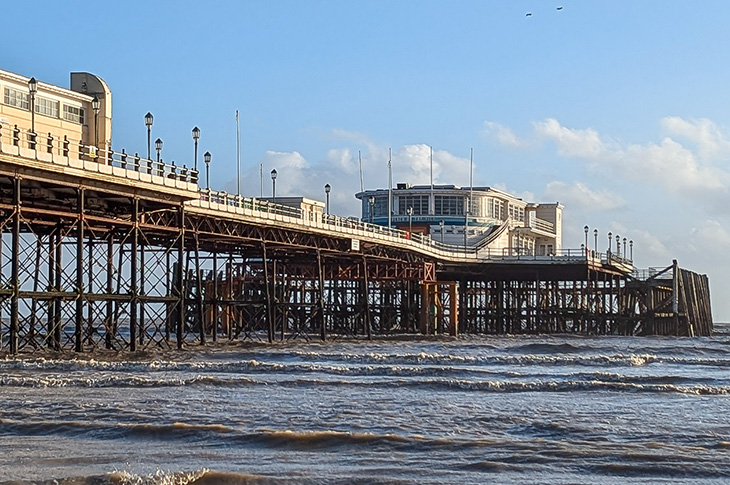
Our scaffolding contractors are currently designing the scaffolding that will be used next week to allow us to complete the project from the above deck without waiting for the next set of spring low tides.
In the meantime, our engineers have done a visual inspection of the pier substructure and drawn up a list of minor repairs that will be carried out through December and January spring low tides. This is routine ongoing maintenance for a structure of the pier's age and includes tightening bolts and replacing tie bars and bull bars and will not affect the reopening of the pier.
Our engineers and contractors have also been able to confirm that a pile of similar age and construction close to those that were damaged has not been affected by the incident and remains in a good condition so will not need to be replaced.
More welding was completed on the pier last night and further bracing was done, which has allowed us to build a platform under the pier so that we can complete the work from above.
This morning a scaffolding team has been on site to examine the pier and design exactly what temporary scaffolding they need to put up that will allow our contractors to safely finish the last stages of the project from above without waiting for the next set of spring low tides.
Photo: lower truss cross bracing completed

Two steel trusses now stretch across the width of the pier, sitting on steel beams that are in turn resting on the six piles that were driven into the seabed last week.
An intensive welding and bracing operation is underway to fix the components together so that the new steel structure can support the weight of the pier in that section.
Unfortunately the bad weather of the last 24 hours has hindered progress by significantly reducing the length of the low tides, so we will need more time to complete the work.
Photo: lifting in the southern truss

Photo: the two trusses in place
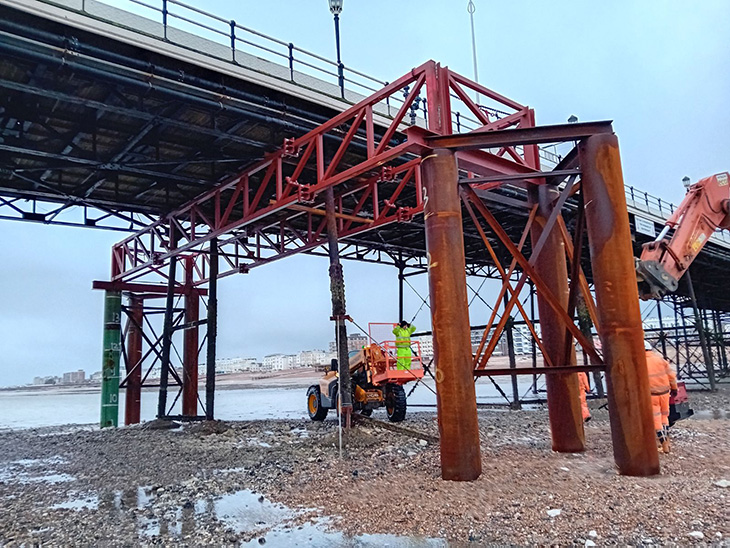
Work on Worthing Pier has continued over the weekend and today, both in daylight and in the dark.
Over the weekend and today our contractors have done a lot of bracing and welding to the six new piles and the supporting beams that now sit on top of those piles.
The next step involves fitting in place the long steel trusses that will stretch under the width of the pier, fixed to the beams on top of the piles.
Photo: the bearing beam works underway
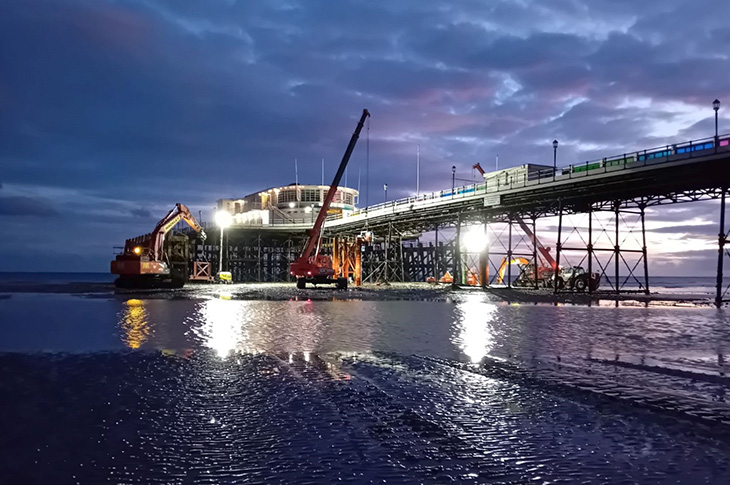
Photo: preparing for the bearing beam, west side
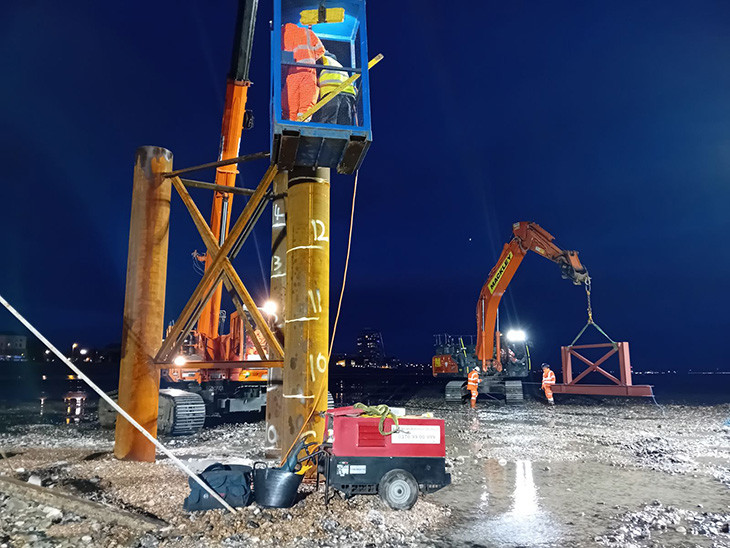
Photo: lifting the bearing beam into place, west side
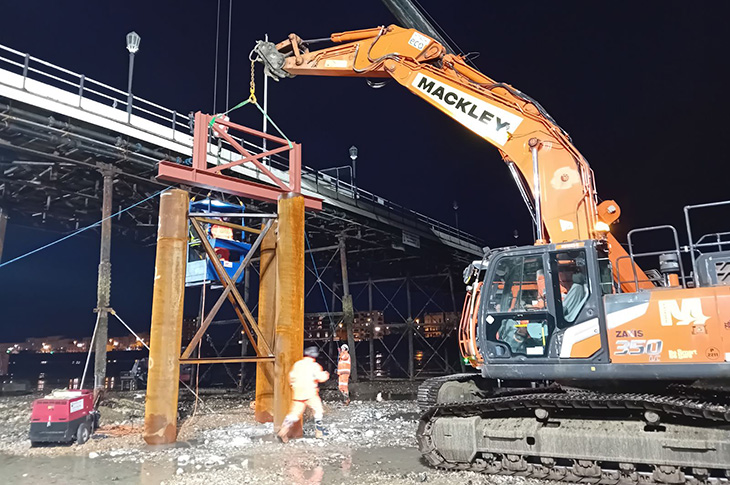
Photo: welding the bearing beam, west side

With all the steel piles now in place, today's work has involved cutting them so they are all exactly the same height above the beach.
The team also began capping and bracing the piles, welding steel tiles and supports between them to give them extra strength before the beams are placed on top of them.
The components for the steel trusses which will sit on top of the piles across the width of the pier are also now on site. Over the weekend they will be assembled at the compound ready for installation.
Photo: the steel trusses which will be installed on top of the piles to support the pier
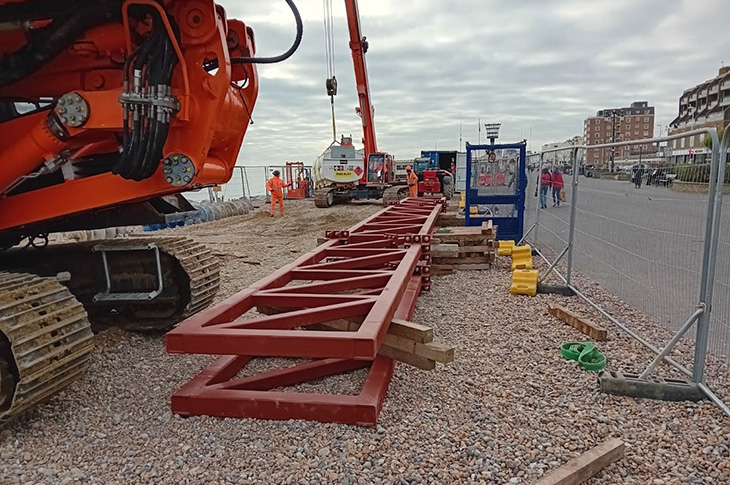
Photos: aerial views of the works on the pier
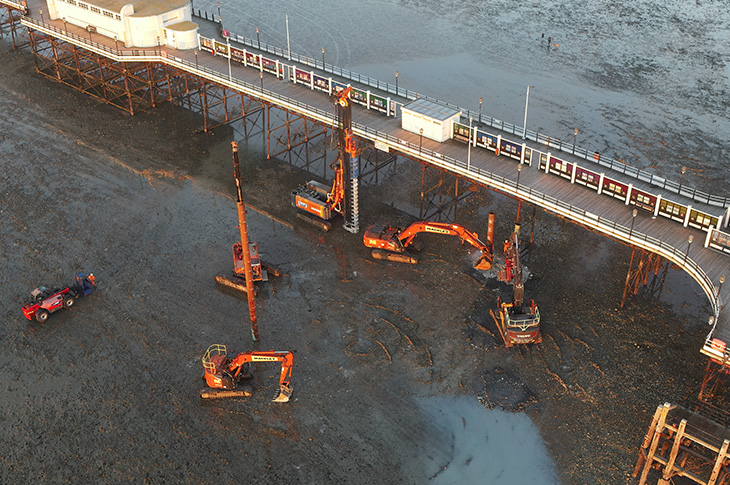
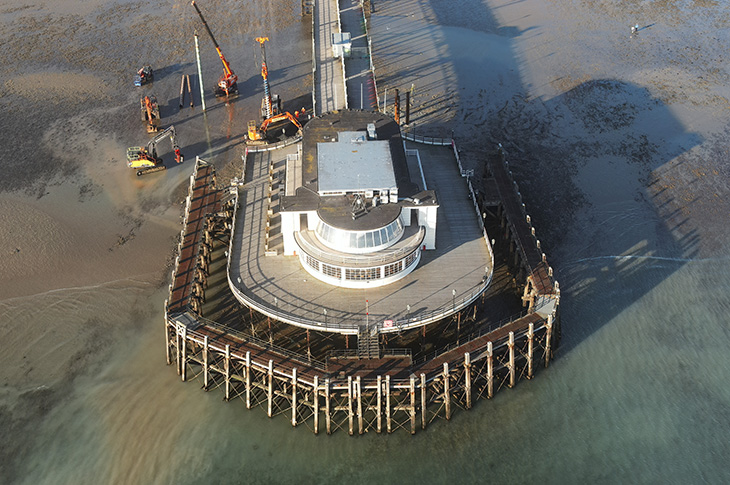
It's been another very productive day for our contractors, with one pile being fitted early this morning and the final three piles this afternoon.
From tomorrow the six piles will be cut to exactly the same height so that the rest of the new steel structure can be fitted to them to support the pier.
Additional materials and machinery will be delivered to our contractors' compound on the seafront tomorrow, which may need to be extended slightly further into the promenade. The promenade will however remain open to the public.
Photos: piles being driven into the seabed next to the pier
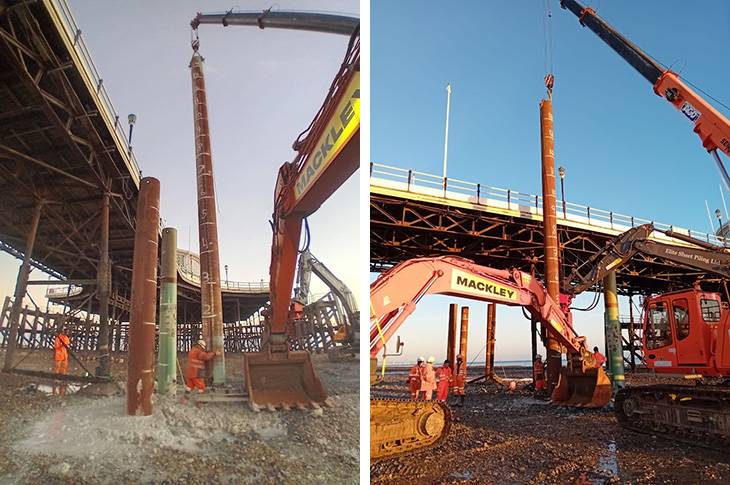
Our contractors have successfully installed the first piles next to the pier as part of the new steel structure that will help support it.
After first scanning the ground to check its stability, the engineers drilled the first two of six holes either side of the pier in which new 15-metre piles will sit. Both piles were then driven into the seabed until only a third of each was left above the surface of the beach.'
The remaining four piles will next be driven into the seabed so that the supporting structure can be built on top of them.
Photos: piles being driven into the seabed next to the pier
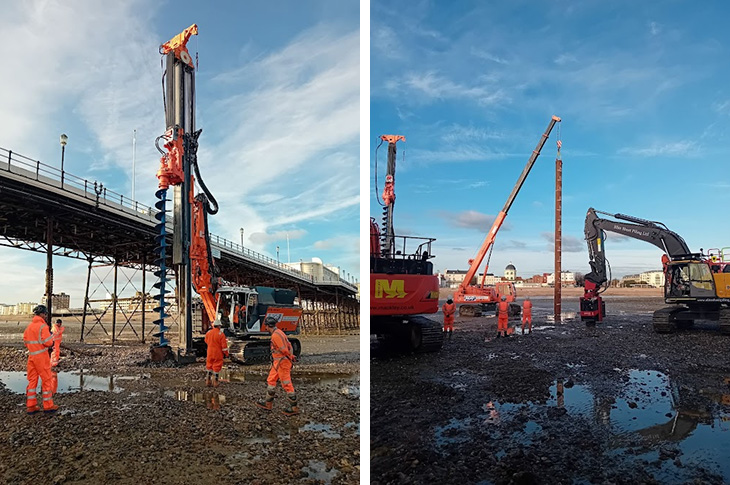
Tomorrow afternoon during the spring low tide our contractors plan to begin work on the temporary fix on the pier.
The work involves driving six 15-metre steel piles into the seabed either side of the pier, and then fitting steel support beams and a 16.5-metre steel truss on top of them.
This new temporary structure will take the weight of that section of the pier and allow us to remove and replace the damaged piles.
Today more equipment and materials have been brought to our contractors' compound between the pier and the lido in readiness for the work beginning.
Photo: equipment and materials in the compound west of the pier
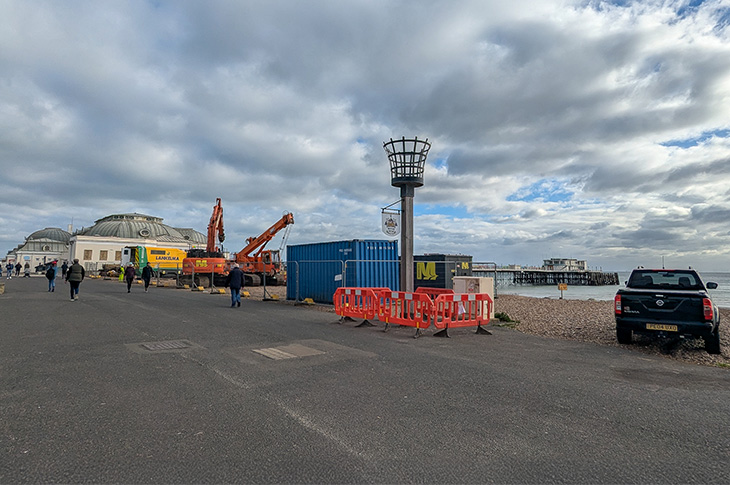
Equipment and materials are building up in our contractors' compound ahead of our urgent work on the pier this week.
That process will continue tomorrow as our contractors ensure they have everything on hand to begin the construction of the additional temporary support for the structure.
We intend to install the first additional temporary pile next to the pier on Wednesday afternoon, as the next series of spring low tides begins.
Photo: equipment in the compound west of the pier

Our contractors have set up their new compound between the pier and the lido today, in advance of the next stage of the project next week.
This work on the additional temporary support for the pier can only be carried out when the sea has gone out far enough for our contractors to work safely on the site which, weather permitting, should mean activity can begin by the middle of next week.
The promenade remains open but has had to be narrowed temporarily so that the equipment and materials can be stored in the fenced off area effectively.
Photo: compound being assembled west of the pier
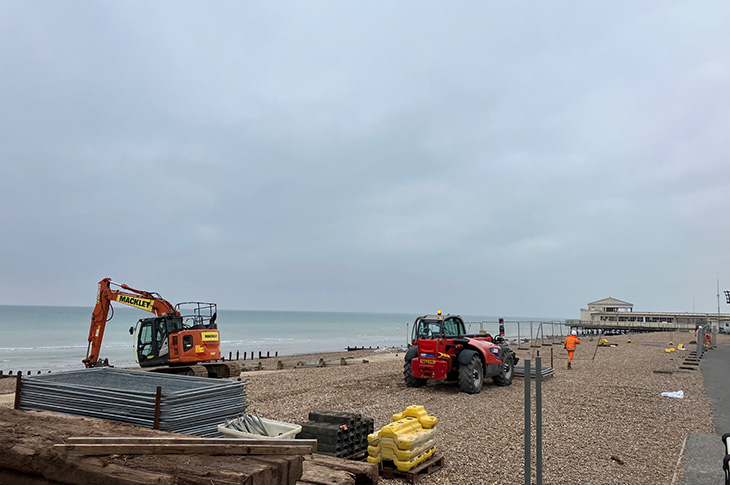
We're gearing up to start work on the additional temporary support for the pier, with the ambition being that this will provide access to the public.
Our contractors are finalising the plans to ensure they have all the materials and equipment to hand and that their teams know exactly what needs to be done on site.
On Friday fencing will be put up around a section of the beach and promenade between the pier and the lido which the workmen will use in addition to the usual compound, for the materials and larger equipment required for this work.
The promenade will remain open but will be narrower than normal while the work is carried out. We will keep disruption to a minimum, but there may be some noise during the work unfortunately.
The pier remains closed and no one should be accessing it until it has been made safe.
After carrying out their investigation work, our specialist structural engineers have been working on plans to undertake a temporary support during the next spring tide (mid-November) that will hopefully mean that we can at least partially reopen the pier to the public.
Last week our contractors were working hard to stabilise the piles near to where the pier suffered the storm damage that forced us to close it earlier this month. That damage meant we had to remove a broken pile to the south of the central pavilion, which has put extra stress on the other piles.
Unfortunately while we were examining the piles on either side of the one that we had to remove, we discovered that they had suffered damage which was hidden from view. We believe this was caused by the extra strain they are currently under from the weight of the pier.
This means that the temporary support to the pier is likely to be more substantial than initially thought, but we are hopeful that they will allow for partial reopening of the pier. This temporary support is due to be carried out in the next tidal window, which is due from 14th November, and is necessary so that our contactors can safely work underneath the pier to complete inspections of the structure and carry out the permanent repairs.
We will know more when our engineers provide us with a full plan for the temporary support and inspections required to understand the permanent repair next week and we will update you on these plans on our website.
We're continuing to keep the businesses affected by the closure updated, with regular conversations about what we're doing, why, and how we can help them. We're working with them to explore possible ways that we can support them while the work on the pier continues.
Photo: engineers under the pier inspecting the structure and piles
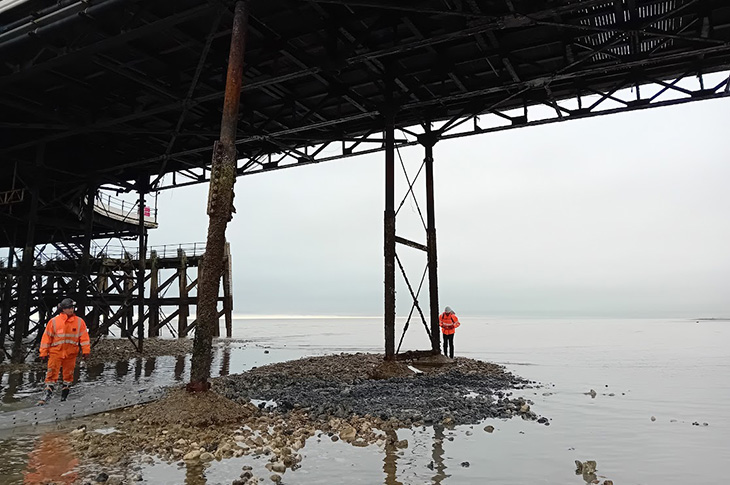
Our contractors have now completed their work to provide extra stability to the piles where that section of the pier has been damaged.
We're now working with structural experts on the repair plans and to secure the parts we need to secure the supports further during the next tidal window in November. We're still hopeful of being able to find a way to reopen the pier to at least a limited number of people before a full repair can take place.
The annual 5th November Worthing Lions fireworks display will not be able to be held on Worthing Pier this year.
We have been keeping the Lions and the pier businesses updated over the past fortnight, since our engineers identified that a pier support had suffered storm damage.
Today we have contacted the Lions to advise them that unfortunately we can't be certain that it will be safe for them to use the pier for the fireworks event next month.
Following on from their work over the weekend, our contractors have today been continuing to stabilise the piles near to where the storm damage happened.
They were on site early this morning and will be there again later this evening while the conditions are still safe enough for them to work.
Our engineers are also continuing with their investigation work at the southern end of the pier and scheduling some ongoing repairs in the sections of the pier closer to the beach.
There have been photos shared on social media that some people are suggesting highlights a lack of maintenance of the pier. In fact, each of those issues had already been identified on our most recent routine inspections, risk assessed and booked in for repair.
It's common for supporting ties to need to be replaced, and we do this regularly as part of our routine maintenance programme.
Our engineers have been continuing their investigation work underneath the pier today to get a more detailed picture of the stability of the structure.
Over the weekend that work will continue. Our contractors will also be on site over the weekend during the spring low tides undertaking routine maintenance works and stabilising the piles near to where the storm damage happened.
Questions you might have
Q. How did the pier get damaged?
A. We believe one of the iron piles that supports the structure was damaged by a large piece of floating debris which has struck the pier during severe weather. We believe the neighbouring piles then suffered further damage caused by the additional strain they were under from the weight of the pier.
Q. When did it happen?
A. We suspect it happened in the days running up to 4th October 2024, during severe weather.
Q. How did you find out?
A. Our engineers carry out regular checks on the pier. On 4th October 2024 they identified that one of the iron piles that support the pier was damaged.
Q. Why did the pier have to close?
A. After we discovered the damage, we sought independent advice from national engineering experts HOP Consulting about the structure, its safety and the required repairs. That advice was clear that there was a risk to the public if we allowed the pier to remain fully open. We therefore closed the pier on the evening of 9th October 2024.
Q. Could the pier have collapsed?
A. The advice that we received did not suggest that any part of the pier structure was likely to fail in the near future. However, the absence of the damaged pile meant that the weight of the pier was putting extra strain on the remaining piles, which increased the risk that one or more of those piles could be further damaged. We are not willing to risk anyone's safety so the pier was closed until we could be confident it could be used safely.
Q. What do you need to do to fix the issue?
A. We need to replace the damaged piles so that they together form a strong support for the pier. That isn't a quick job, so in the interim, we have installed a steel structure to provide more support for the pier so that we could reopen it as soon as possible. Our engineers and contractors are working on a longer-term solution that involves replacing the damaged piles safely.
Q. When did the pier reopen?
A. The pier reopened on Wednesday 4th December 2024.
Q. How much maintenance do you do on the pier?
A. Our engineers carry out regular inspections of both the pier's decking and the substructure underneath.
The pier's timber decking is inspected every month. Timbers are replaced on a rotation basis, as sections reach the end of their 25-year lifespan. At the same time as this work is being done we also examine the substructure of the pier underneath and clean and repaint any trusses or deck beams to give them greater protection from the elements. If the trusses or deck beams are not in a good condition they are removed and replaced.
The substructure of the pier is inspected quarterly and any necessary repairs are carried out. The way we carry out these inspections was independently assessed in 2018 by HOP Consulting, which said that this approach was keeping the pier in a good overall condition.
There have been some inaccurate comments made on social media that have implied that we have reduced our maintenance of the pier. In fact, we have continued to increase the amount we spend on reactive maintenance for the pier over recent years.
Over the last two financial years (from April 2022 to March 2024) we have spent £450,531 on maintenance and repairs to the pier. By comparison, we spent £339,586 in total over the previous three years (from April 2019 to March 2022).
Q. How much is this going to cost the council to resolve?
A. We have a budget for repairs to the pier which will go towards the cost of the repairs needed. However based on the information we currently have (as of 12th November 2024) we fully expect that the overall cost of the identified work to stabilise the pier to make it safe to reopen will be in excess of £430,000, much of which we will need to find from our other budgets.
See also:

Need assistance with this service?
Get in touch:
Coastal Office
Problem with this page?
Page last updated: 17 December 2025

